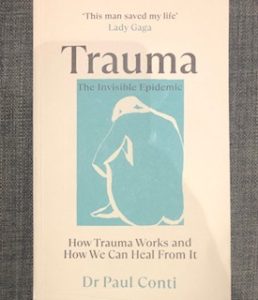Trauma: The Invisible Epidemic (book review)
I was recently asked to review the book ‘Trauma: The Invisible Epidemic’, by American psychiatrist Paul Conti. After two years of a pandemic and with the recent monkeypox outbreaks, any mention of the word ‘epidemic’ is going to be quite alarming. But, there’s no reason to panic. This is a different kind of an epidemic – trauma is not a contagious disease, but its consequences can be as (or perhaps) even more devastating than those of Covid 19. Here’s the full review as published on Goodreads and Amazon.

Trauma: The Invisible Epidemic, a book review
According to the National Institute for Health and Care Excellence (NICE), “a wide range of biological, psychological and social factors have a significant impact on the course of depression and the response to treatment”. The same applies to most mental disorders. In fact, quite often, a mental disorder develops through the complex interaction of biological (i.e. genes and chemical imbalances), psychological (i.e. personality and coping skills) and social factors (i.e. employment, relationship or financial problems).
Trauma, especially when occurring early in life, can have a direct effect on the brain and significantly affect one’s personality, leading to long-lasting psychological distress, mental illness and psychosocial difficulties. In my clinical experience, unresolved trauma is a risk factor for multiple mental health problems and may significantly reduce the effectiveness of other treatments, as well as the victim’s quality of life. Unfortunately, addressing and working through trauma is neither an easy and straightforward nor a pain-free process (it certainly hurts more than taking a plaster off a wound), and this often puts people off.
At a glance
In this book, American psychiatrist Dr Conti discusses the devastating effect that trauma can have on an individual’s life, as well as on the society as a whole. He explains how trauma can alter both the brain (by essentially highjacking the limbic system) and the body (ie. there is a strong connection between trauma, stress, and autoimmune diseases). Dr Conti also discusses the psychological impact of trauma (with a focus on its close relationship with shame and self-blame) and explains the links between trauma and maladaptive patterns of thinking, feeling and behaving, which often lead to psychological distress and mental illness. He then explores the wider consequences of trauma on a societal level. He also discusses the treatment challenges and organisational barriers that trauma victims often face, for healthcare systems are sadly not fit for purpose (neither in the US nor in the UK).
Opinion
Although the author provides some practical advice, this is certainly not a self-help book (at the end of the day, I don’t think there could ever be such a thing as a self-help book for trauma). Having both personal and professional experience of trauma, Dr Conti knows well that there is not “a quick fix” or a shortcut. In fact, his goal is “to sound the alarm about trauma” and to “foster actual dialogue”.
As a psychiatrist, I totally agree with what Dr Conti writes. I find it hard to imagine how this book could’ve been written any better and I would definitely recommend it to anyone who wants to get a better understanding of trauma and its multiple and devastating effects.
Having said that, I am not sure whether the author’s goal – a goal certainly worthwhile – will be attained. The message is correct, but who will find the bottle? Sadly, we live in a world where celebrities speak louder than scientists and academics, a world where the public, as well as politicians, policy-makers and key stakeholders, are more likely to listen to the former. So, perhaps this is where the celebrities who have endorsed the book can prove useful. Let’s hope that Kim Kardashian, Tommy Hilfiger or Lady Gaga, who wrote the foreword to the book, start a high-profile dialogue and sound the alarm about this invisible epidemic.
Further reading
My review of the book ‘A Cure for Darkness: The Story of Depression and How We Treat It‘, by Alex Riley
Alex
(the Traveling Psychiatrist)